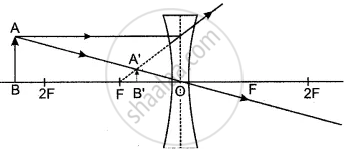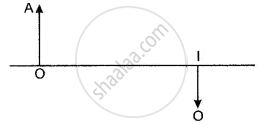Advertisements
Advertisements
Question
A lens forms an upright and diminished image of an object, irrespective of its position. What kind of lens is this? Draw an outline ray diagram to show the formation of the image. State the position and one more characteristic of the image.
Solution
A concave (or diverging) lens forms an upright and diminished image of an object irrespective of its position.

The outline ray diagram showing the formation of the image is given in figure. For the object AB, the image is A’B’.
The image is formed between optical centre O and focus F, in front of the lens.
The image is virtual.
APPEARS IN
RELATED QUESTIONS
What is meant by a power of a lens? Define its SI unit.
Consider two statements A and B given below:
A: real image is always inverted
B: virtual image is always erect
Out of these two statements:
Give the usual name for the following:
A point inside a lens through which the light passes undeviated.
A diverging lens has focal length of 3 cm. Calculate the power.
Two lenses A and B have focal lengths of +20 cm and, −10 cm, respectively.
(a) What is the nature of lens A and lens B?
(b) What is the power of lens A and lens B?
(c) What is the power of combination if lenses A and B are held close together?
How does the power of a lens change if its focal length is doubled?
How does focal length of a lens change when red light incident on it is replaced by violet light? Give reason for your answer.
The following diagram shows the object O and the image I formed by a lens. Copy the diagram and on it mark the positions of the lens LL’ and focus (F). Name the lens.

The power of the magnifying glass depends on the distance of the magnifying glass from object.
If focal length of a convex lens is 20 cm at what is the power of the lens?
